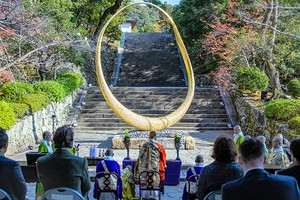By LISA VOGT/ Special to Asahi Weekly
March 8, 2022 at 07:00 JST
As the Apple-trademarked phrase “There’s an app for that” states, there really was an app, no, several apps, for what I was looking for.
In elementary school, I avoided the loo between classes because it was crowded. I was overly conscious about others hearing the sound I might make as I relieved myself.
They are sounds that everyone makes, but I squirmed with discomfort even at the thought. The savior, “Sound Princess,” did not exist in my day. Now I have several sound-masking apps on my phone standing by whenever need be.
While the oto-keshi-no-tsubo, or sound-drowning urn, has been in use since the Edo Period (1603-1867), Toto’s Otohime brand put the product and concept into people’s consciousness.
Toto (short for Toyo Toki) was established in 1917 in Kita-Kyushu. A decade or so ago, I visited the original Toto Museum, which simply consisted of Toto products on display in chronological order in a building that might have been one of their factories in years past. Although it was old and stuffy, I remember being so wowed at what I saw that I vowed to return someday.
To commemorate its 100th anniversary, a sparkling new four-story Toto Museum was constructed. It consists of two gleaming white structures, one the shape of a humongous water droplet. The impressive compound is airy, spacious and gorgeously modern. The old museum “moved” me and made me “feel” things. The updated version “informed” and “educated.”
Japan today is world-renowned for its sophisticated toilets, thanks to Toto. In 1903, Kazuchika Okura (1875-1955) saw ceramic toilet bowls in Europe and thought, “This is my mission. I’m going to modernize Japanese bathrooms!” He returned to Japan and started Toyo Toki.
He made the country’s first ceramic seated flush toilet in 1914. However, the amazing thing is that plumbing was not yet available in Japan! It was a classic case of, “If you build it, they will come.” And yes, plumbing came, flushing Toto with success.
Toto’s watershed moment came in 1980 when the company integrated a European bidet into an electronic toilet seat, creating the Washlet, a term that has become almost generic.
At the museum, you can see the company’s seminal products and their evolution, group companies (all having to do with ceramics), history of plumbing and products like bath units, and in a separate gallery, Toto products sold around the world.
Toto revolutionized the modern toilet, flushing out the shyness many people felt about toilet topics. Toto, the throne is yours.
* * *
This article by Lisa Vogt, a Washington-born and Tokyo-based photographer, originally appeared in the Feb. 6 issue of Asahi Weekly. It is part of the series "Lisa’s Wanderings Around Japan," which depicts various places across the country through the perspective of the author, a professor at Meiji University.




















A peek through the music industry’s curtain at the producers who harnessed social media to help their idols go global.
A series based on diplomatic documents declassified by Japan’s Foreign Ministry
Here is a collection of first-hand accounts by “hibakusha” atomic bomb survivors.
Cooking experts, chefs and others involved in the field of food introduce their special recipes intertwined with their paths in life.
A series about Japanese-Americans and their memories of World War II